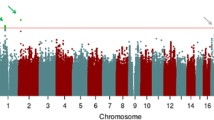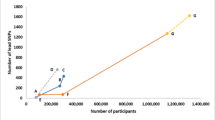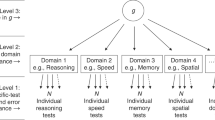Abstract
Cognitive ability has a substantial genetic component and more than 15 candidate genes have been identified over the past 8 years. One gene that has been associated with general cognitive ability is the cholinergic muscarinic 2 receptor (CHRM2). In an attempt to replicate this finding we typed marker rs8191992 (the originally reported CHRM2 SNP) in two population based cohorts—one Scottish aged over 50 years (N = 2,091) and the other English comprising non-demented elderly participants (N = 758)—and a family-based Australian adolescent sample (N = 1,537). An additional 29 SNPs in CHRM2 were typed in the Australian sample and a further seven in the English cohort. No significant association was found between CHRM2 and diverse measures of cognitive ability in any of the samples. In conclusion, this study does not support a role for CHRM2 in cognitive ability.

Similar content being viewed by others
References
Abecasis GR, Cardon LR, Cookson WO (2000a) A general test of association for quantitative traits in nuclear families. Am J Hum Genet 66:279–292. doi:10.1086/302698
Abecasis GR, Cookson WO, Cardon LR (2000b) Pedigree tests of transmission disequilibrium. Eur J Hum Genet 8:545–551. doi:10.1038/sj.ejhg.5200494
Abecasis GR, Ghosh D, Nichols TE (2005) Linkage disequilibrium: ancient history drives the new genetics. Hum Hered 59:118–124. doi:10.1159/000085226
Aubert I, Araujo DM, Cecyre D, Robitaille Y, Gauthier S, Quirion R (1992) Comparative alterations of nicotinic and muscarinic binding sites in Alzheimer’s and Parkinson’s diseases. J Neurochem 58:529–541. doi:10.1111/j.1471-4159.1992.tb09752.x
Barnett JH, Heron J, Ring SM, Golding J, Goldman D, Xu K, Jones PB (2007) Gender-specific effects of the catechol-O-methyltransferase Val108/158Met polymorphism on cognitive function in children. Am J Psychiatry 164:142–149. doi:10.1176/appi.ajp.164.1.142
Barnett JH, Scoriels L, Munafo MR (2008) Meta-analysis of the cognitive effects of the catechol-O-methyltransferase gene Val158/108Met polymorphism. Biol Psychiatry 64:137–144. doi:10.1016/j.biopsych.2008.01.005
Barrett JC, Fry B, Maller J, Daly MJ (2005) Haploview: analysis and visualization of LD and haplotype maps. Bioinformatics (Oxford, England) 21:263–265. doi:10.1093/bioinformatics/bth457
Bouchard TJ Jr, McGue M (2003) Genetic and environmental influences on human psychological differences. J Neurobiol 54:4–45. doi:10.1002/neu.10160
Bruder GE, Keilp JG, Xu H, Shikhman M, Schori E, Gorman JM, Gilliam TC (2005) Catechol-O-methyltransferase (COMT) genotypes and working memory: associations with differing cognitive operations. Biol Psychiatry 58:901–907. doi:10.1016/j.biopsych.2005.05.010
Calabresi P, Centonze D, Gubellini P, Pisani A, Bernardi G (1998) Blockade of M2-like muscarinic receptors enhances long-term potentiation at corticostriatal synapses. Eur J Neurosci 10:3020–3023. doi:10.1111/j.1460-9568.1998.00348.x
Carey GJ, Billard W, Binch HIII, Cohen-Williams M, Crosby G, Grzelak M, Guzik H, Kozlowski JA, Lowe DB, Pond AJ, Tedesco RP, Watkins RW, Coffin VL (2001) SCH 57790, a selective muscarinic M(2) receptor antagonist, releases acetylcholine and produces cognitive enhancement in laboratory animals. Eur J Pharmacol 431:189–200. doi:10.1016/S0014-2999(01)01440-6
Carroll JB (1993) Human mental abilities: a survey of factor analytic studies. Cambridge University Press, Cambridge
Comings DE, Wu S, Rostamkhani M, McGue M, Iacono WG, MacMurray JP (2002) Association of the muscarinic cholinergic 2 receptor (CHRM2) gene with major depression in women. Am J Med Genet 114:527–529. doi:10.1002/ajmg.10406
Comings DE, Wu S, Rostamkhani M, McGue M, Lacono WG, Cheng LS, MacMurray JP (2003) Role of the cholinergic muscarinic 2 receptor (CHRM2) gene in cognition. Mol Psychiatry 8:10–11. doi:10.1038/sj.mp.4001095
Crawford JR, Deary IJ, Starr J, Whalley LJ (2001) The NART as an index of prior intellectual functioning: a retrospective validity study covering a 66-year interval. Psychol Med 31:451–458. doi:10.1017/S0033291701003634
de Frias CM, Annerbrink K, Westberg L, Eriksson E, Adolfsson R, Nilsson LG (2005) Catechol O-methyltransferase Val158Met polymorphism is associated with cognitive performance in nondemented adults. Journal of Cogn Neurosci 17:1018–1025. doi:10.1162/0898929054475136
Deary IJ, Spinath FM, Bates TC (2006) Genetics of intelligence. Eur J Hum Genet 14:690–700. doi:10.1038/sj.ejhg.5201588
Deary IJ, Strand S, Smith P, Fernandes C (2007) Intelligence and educational achievement. Intelligence 35:13–21. doi:10.1016/j.intell.2006.02.001
Devlin B, Daniels M, Roeder K (1997) The heritability of IQ. Nature 388:468–471. doi:10.1038/41319
Dick DM, Aliev F, Kramer J, Wang JC, Hinrichs A, Bertelsen S, Kuperman S, Schuckit M, Nurnberger J Jr, Edenberg HJ, Porjesz B, Begleiter H, Hesselbrock V, Goate A, Bierut L (2007) Association of CHRM2 with IQ: converging evidence for a gene influencing intelligence. Behav Genet 37:265–272. doi:10.1007/s10519-006-9131-2
Dick DM, Aliev F, Wang JC, Grucza RA, Schuckit M, Kuperman S, Kramer J, Hinrichs A, Bertelsen S, Budde JP, Hesselbrock V, Porjesz B, Edenberg HJ, Bierut LJ, Goate A (2008) Using dimensional models of externalizing psychopathology to aid in gene identification. Arch Gen Psychiatry 65:310–318
Edenberg HJ, Foroud T (2006) The genetics of alcoholism: identifying specific genes through family studies. Addict Biol 11:386–396. doi:10.1111/j.1369-1600.2006.00035.x
Fisher A, Brandeis R, Bar-Ner RH, Kliger-Spatz M, Natan N, Sonego H, Marcovitch I, Pittel Z (2002) AF150(S) and AF267B: M1 muscarinic agonists as innovative therapies for Alzheimer’s disease. J Mol Neurosci 19:145–153. doi:10.1007/s12031-002-0025-3
Fowkes FG, Murray GD, Butcher I, Heald CL, Lee RJ, Chambless LE, Folsom AR, Hirsch AT, Dramaix M, deBacker G, Wautrecht JC, Kornitzer M, Newman AB, Cushman M, Sutton-Tyrrell K, Fowkes FG, Lee AJ, Price JF, d’Agostino RB, Murabito JM, Norman PE, Jamrozik K, Curb JD, Masaki KH, Rodriguez BL, Dekker JM, Bouter LM, Heine RJ, Nijpels G, Stehouwer CD, Ferrucci L, McDermott MM, Stoffers HE, Hooi JD, Knottnerus JA, Ogren M, Hedblad B, Witteman JC, Breteler MM, Hunink MG, Hofman A, Criqui MH, Langer RD, Fronek A, Hiatt WR, Hamman R, Resnick HE, Guralnik J, McDermott MM (2008) Ankle brachial index combined with Framingham Risk Score to predict cardiovascular events and mortality: a meta-analysis. J Am Med Assoc 300:197–208. doi:10.1001/jama.300.2.197
Gabriel SB, Schaffner SF, Nguyen H, Moore JM, Roy J, Blumenstiel B, Higgins J, DeFelice M, Lochner A, Faggart M, Liu-Cordero SN, Rotimi C, Adeyemo A, Cooper R, Ward R, Lander ES, Daly MJ, Altshuler D (2002) The structure of haplotype blocks in the human genome. Science 296:2225–2229. doi:10.1126/science.1069424
Gosso MF, van Belzen M, de Geus EJ, Polderman JC, Heutink P, Boomsma DI, Posthuma D (2006) Association between the CHRM2 gene and intelligence in a sample of 304 Dutch families. Genes Brain Behav 5:577–584. doi:10.1111/j.1601-183X.2006.00211.x
Gosso FM, de Geus EJ, Polderman TJ, Boomsma DI, Posthuma D, Heutink P (2007) Exploring the functional role of the CHRM2 gene in human cognition: results from a dense genotyping and brain expression study. BMC Med Genet 8:66. doi:10.1186/1471-2350-8-66
Harris SE, Fox H, Wright AF, Hayward C, Starr JM, Whalley LJ, Deary IJ (2007) A genetic association analysis of cognitive ability and cognitive ageing using 325 markers for 109 genes associated with oxidative stress or cognition. BMC Genet 8:43. doi:10.1186/1471-2156-8-43
Heald CL, Fowkes FG, Murray GD, Price JF (2006) Risk of mortality and cardiovascular disease associated with the ankle-brachial index: systematic review. Atherosclerosis 189:61–69. doi:10.1016/j.atherosclerosis.2006.03.011
Heim AW (1970) Intelligence and personality: their assessment and relationship. Penguin, Harmondsworth
Hemminger BM, Saelim B, Sullivan PF (2006) TAMAL: an integrated approach to choosing SNPs for genetic studies of human complex traits. Bioinformatics (Oxford, England) 22:626–627. doi:10.1093/bioinformatics/btk025
Jackson DN (1984) Manual for the multidimensional aptitude battery. Research Psychologists Press, Port Huron
Jackson DN (1998) Multidimensional aptitude battery II. Sigma Assessment Sytem, Inc., Port Huron
Jensen AR (1998) The g factor: the science of mental ability. Praeger, Westport
Jones KA, Porjesz B, Almasy L, Bierut L, Goate A, Wang JC, Dick DM, Hinrichs A, Kwon J, Rice JP, Rohrbaugh J, Stock H, Wu W, Bauer LO, Chorlian DB, Crowe RR, Edenberg HJ, Foroud T, Hesselbrock V, Kuperman S, Nurnberger J Jr, O’Connor SJ, Schuckit MA, Stimus AT, Tischfield JA, Reich T, Begleiter H (2004) Linkage and linkage disequilibrium of evoked EEG oscillations with CHRM2 receptor gene polymorphisms: implications for human brain dynamics and cognition. Int J Psychophysiol 53:75–90. doi:10.1016/j.ijpsycho.2004.02.004
Jones KA, Porjesz B, Almasy L, Bierut L, Dick D, Goate A, Hinrichs A, Rice JP, Wang JC, Bauer LO, Crowe R, Foroud T, Hesselbrock V, Kuperman S, Nurnberger J Jr, O’Connor SJ, Rohrbaugh J, Schuckit MA, Tischfield J, Edenberg HJ, Begleiter H (2006) A cholinergic receptor gene (CHRM2) affects event-related oscillations. Behav Genet 36:627–639. doi:10.1007/s10519-006-9075-6
Lai MK, Lai OF, Keene J, Esiri MM, Francis PT, Hope T, Chen CP (2001) Psychosis of Alzheimer’s disease is associated with elevated muscarinic M2 binding in the cortex. Neurology 57:805–811
Lezak MD (1982) Neuropsychological assessment. Oxford University Press, New York
Luciano M, Wright MJ, Geffen GM, Geffen LB, Smith GA, Martin NG (2004) A genetic investigation of the covariation among inspection time, choice reaction time, and IQ subtest scores. Behav Genet 34:41–50. doi:10.1023/B:BEGE.0000009475.35287.9d
Luo X, Kranzler HR, Zuo L, Wang S, Blumberg HP, Gelernter J (2005) CHRM2 gene predisposes to alcohol dependence, drug dependence and affective disorders: results from an extended case-control structured association study. Hum Mol Genet 14:2421–2434. doi:10.1093/hmg/ddi244
McClearn GE, Johansson B, Berg S, Pedersen NL, Ahern F, Petrill SA, Plomin R (1997) Substantial genetic influence on cognitive abilities in twins 80 or more years old. Science 276:1560–1563. doi:10.1126/science.276.5318.1560
McGregor B, Pfitzner J, Zhu G, Grace M, Eldridge A, Pearson J, Mayne C, Aitken JF, Green AC, Martin NG (1999) Genetic and environmental contributions to size, color, shape, and other characteristics of melanocytic naevi in a sample of adolescent twins. Genet Epidemiol 16:40–53. doi:10.1002/(SICI)1098-2272(1999)16:1<40::AID-GEPI4>3.0.CO;2-1
Miyajima F, Quinn JP, Horan M, Pickles A, Ollier WE, Pendleton N, Payton A (2008) Additive effect of BDNF and REST polymorphisms is associated with improved general cognitive ability. Genes Brain Behav 7:714–719. doi:10.1111/j.1601-183X.2008.00409.x
Nyholt DR (2006) On the probability of dizygotic twins being concordant for two alleles at multiple polymorphic loci. Twin Res Hum Genet 9:194–197. doi:10.1375/twin.9.2.194
Payton A (2006) Investigating cognitive genetics and its implications for the treatment of cognitive deficit. Genes Brain Behav 5(Suppl 1):44–53. doi:10.1111/j.1601-183X.2006.00194.x
Pertusa M, Garcia-Matas S, Mammeri H, Adell A, Rodrigo T, Mallet J, Cristofol R, Sarkis C, Sanfeliu C (2008) Expression of GDNF transgene in astrocytes improves cognitive deficits in aged rats. Neurobiol Aging 29:1366–1379. doi:10.1016/j.neurobiolaging.2007.02.026
Polderman TJ, Gosso MF, Posthuma D, Van Beijsterveldt TC, Heutink P, Verhulst FC, Boomsma DI (2006) A longitudinal twin study on IQ, executive functioning, and attention problems during childhood and early adolescence. Acta Neurol Belg 106:191–207
Price JF, Stewart MC, Douglas AF, Murray GD, Fowkes GF (2008) Frequency of a low ankle brachial index in the general population by age, sex and deprivation: cross-sectional survey of 28, 980 men and women. Eur J Cardiovasc Prev Rehabil 15:370–375. doi:10.1097/HJR.0b013e3282f8b36a
Purcell S, Cherny SS, Sham PC (2003) Genetic power calculator: design of linkage and association genetic mapping studies of complex traits. Bioinformatics (Oxford, England) 19:149–150. doi:10.1093/bioinformatics/19.1.149
Purcell S, Neale B, Todd-Brown K, Thomas L, Ferreira MA, Bender D, Maller J, Sklar P, de Bakker PI, Daly MJ, Sham PC (2007) PLINK: a tool set for whole-genome association and population-based linkage analyses. Am J Hum Genet 81:559–575. doi:10.1086/519795
Rabbitt PMA, McInnes L, Diggle P, Holland F, Bent N, Abson V, Pendleton N, Horan M (2004) The University of Manchester longitudinal Study of cognition in normal healthy old age, 1983 through 2003. Neuropsychol Dev Cogn B Aging Neuropsychol Cogn 11:245–279. doi:10.1080/13825580490511116
Raven JC (1965) Mill Hill vocabulary scale. H. K. Lewis, London
Raven J, Raven JC, Court JH (1998) Raven manual: standard progressive matrices. Oxford Psychologists Press, Oxford
Savitz J, Solms M, Ramesar R (2006) The molecular genetics of cognition: dopamine, COMT and BDNF. Genes Brain Behav 5:311–328. doi:10.1111/j.1601-183X.2005.00163.x
Silva AJ (2003) Molecular and cellular cognitive studies of the role of synaptic plasticity in memory. J Neurobiol 54:224–237. doi:10.1002/neu.10169
Stewart MC, Deary IJ, Fowkes FG, Price JF (2006) Relationship between lifetime smoking, smoking status at older age and human cognitive function. Neuroepidemiology 26:83–92. doi:10.1159/000090253
Underhill PA, Jin L, Lin AA, Mehdi SQ, Jenkins T, Vollrath D, Davis RW, Cavalli-Sforza LL, Oefner PJ (1997) Detection of numerous Y chromosome biallelic polymorphisms by denaturing high-performance liquid chromatography. Genome Res 7:996–1005
Wang JC, Hinrichs AL, Stock H, Budde J, Allen R, Bertelsen S, Kwon JM, Wu W, Dick DM, Rice J, Jones K, Nurnberger JI Jr, Tischfield J, Porjesz B, Edenberg HJ, Hesselbrock V, Crowe R, Schuckit M, Begleiter H, Reich T, Goate AM, Bierut LJ (2004) Evidence of common and specific genetic effects: association of the muscarinic acetylcholine receptor M2 (CHRM2) gene with alcohol dependence and major depressive syndrome. Hum Mol Genet 13:1903–1911. doi:10.1093/hmg/ddh194
Wechsler D (1981) Wechsler adult intelligence scale-revised. Psychological Corporation, New York
Wigginton JE, Abecasis GR (2005) PEDSTATS: descriptive statistics, graphics and quality assessment for gene mapping data. Bioinformatics (Oxford, England) 21:3445–3447. doi:10.1093/bioinformatics/bti529
Wright MJ, Martin NG (2004) Brisbane adolescent twin study: outline of study methods and research projects. Aust J Psychol 56:65–78. doi:10.1080/00049530410001734865
Zhu G, Duffy DL, Eldridge A, Grace M, Mayne C, O’Gorman L, Aitken JF, Neale MC, Hayward NK, Green AC, Martin NG (1999) A major quantitative-trait locus for mole density is linked to the familial melanoma gene CDKN2A: a maximum-likelihood combined linkage and association analysis in twins and their sibs. Am J Hum Genet 65:483–492. doi:10.1086/302494
Acknowledgments
We thank the participants and their families for their cooperation. Australian data collection was funded by ARC grants (A79600334, A79906588, A79801419, DP0212016, DP0343921) and the Human Frontiers of Science Program (HFSP; Grant rg0154/1998-B). Blood collection and DNA extraction for the Dyne Steele cohort was partly funded by Research into Ageing. The AAA Trial is funded by the Wellcome Trust, British Heart Foundation and Chief Scientist Office of the Scottish Executive. SHE, IJD and JFP are members of the University of Edinburgh Centre for Cognitive Ageing and Cognitive Epidemiology part of the UK’s cross council Lifelong Health and Wellbeing Initiative; funding from the BBSRC, EPSRC, ESRC and MRC is gratefully acknowledged.
Conflict of interest statement
The authors report no biomedical financial interests or potential conflicts of interest.
Author information
Authors and Affiliations
Corresponding author
Additional information
The authors wish it to be known that, in their opinion, the first two authors should be regarded as joint First Authors.
Edited by Chandra A. Reynolds.
Rights and permissions
About this article
Cite this article
Lind, P.A., Luciano, M., Horan, M.A. et al. No Association Between Cholinergic Muscarinic Receptor 2 (CHRM2) Genetic Variation and Cognitive Abilities in Three Independent Samples. Behav Genet 39, 513–523 (2009). https://doi.org/10.1007/s10519-009-9274-z
Received:
Accepted:
Published:
Issue Date:
DOI: https://doi.org/10.1007/s10519-009-9274-z




